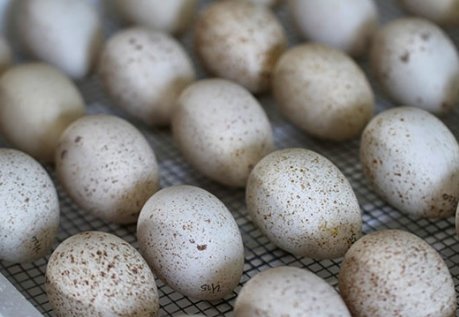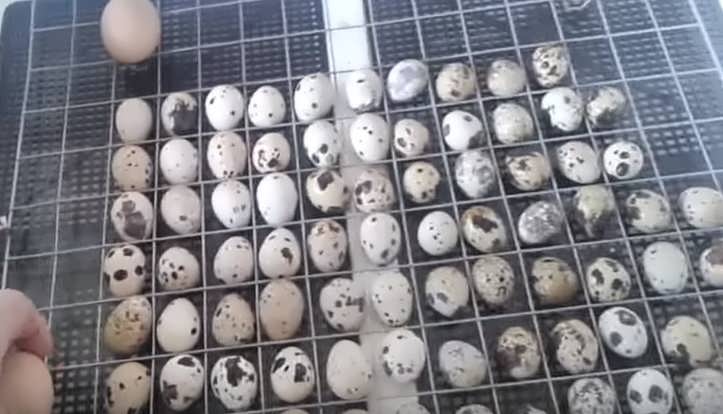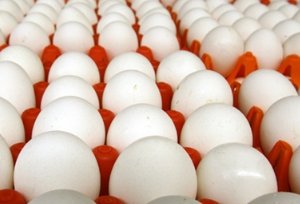The maternal instinct of guinea fowls is rather poorly developed in comparison with other poultry. It is advisable to breed cesareans with the help of an incubator . The breeding process does not take much time, it is enough to observe the humidity, maintain the required temperature. When the chicks have hatched, the necessary conditions for their growth should be provided.
Incubation of guinea fowl eggs
A guinea fowl, if provided with the right conditions, can lay eggs for 6 months a year. By maintaining the correct lighting and temperature, the duration is increased by another 3 months. For eggs to be fertilized, 1 male is required for 4 females. One of the important stages in the incubation of guinea fowl eggs is the selection of material that will be laid.
3 weeks before the start of the process, it is required to intensively feed the females. A mash, fish (it should be finely chopped), cottage cheese are added to the diet. The stirrer is made with sour milk. After the specified period, caesar eggs are selected. They must meet the requirements:
- Be the right shape.
- The shell is clean, without strong pigmentation.
- Smooth to the touch.
- No damage.
- Weight is average.
- Marble coloring is absent.
You can take eggs only from birds that are already one year old. Guinea fowl gives offspring from 8 months. Depending on how many days the eggs lie, the quality of the brood will be formed. It is desirable that the material enters the incubator after 3 weeks from the date of laying. Using an ovoscope, you can determine if there is an embryo in the egg.
Important: in order to get more quality material, cleanliness is constantly maintained in the house, the room must be dry.
It is impossible to use dirty eggs, otherwise the shell will collapse, the pores will become clogged. The full development of offspring and normal breathing will be difficult. Eggs that have irregularities, roughness, give weak young. With small material, non-viable chicks hatch. Marble eggs do not give offspring at all.
Weight recommendations for home incubation:
- if reproduction of birds is necessary: 38-50 g;
- if reproduction of birds for meat is required: 36-52 g.
Collect eggs no longer than 7 days. It is optimal to perform the procedure up to 18 hours, to make a fence every 3-4 hours. Before the start of the collection, the following rules are observed:
- Wash hands thoroughly before collecting incubation material.
- Store the material in a room with a temperature of more than 10°C. Sunlight should not enter the room.
- The humidity level of the material storage room should not exceed 80%.
- You can lay eggs with a blunt end for no longer than 8 days.
Incubator Requirements
Within 28 days, the temperature regime is provided by an incubator. The device also maintains a certain humidity in the place of incubation. Deviations from the norm can quickly freeze the incubation material. It is important to have a battery so that in the event of a power outage, the embryo is not frozen.
The required level of humidity is achieved by using an evaporator. Thermometer readings should be monitored. In the incubator, protection against overheating of the material is installed - exceeding the temperature regime will destroy the offspring in a couple of minutes.
During the entire period of incubation, eggs emit about 3.5 liters of carbon dioxide and take in at least 4 liters of oxygen. The incubator must have holes for normal gas exchange. If the eggs turn over automatically , they are placed in trays with blunt ends up. When manually turned over, the eggs are marked to make it easier to navigate, stacked sideways.
Features of the withdrawal of guinea fowl
You can hatch guinea fowl using simple incubatorsused to hatch other chickens. Mode requirements are slightly different. It is important to maintain a normal microclimate inside the chamber.
Table of temperatures during the incubation period.
One of the important tasks is to remove material that has undergone a rotting process. Checking during incubation is performed 4 times. For this, equal time intervals are counted. With the help of an ovoscope, the eggs are translucent, you can track the development of the embryo.
Selection stages:
- On the 8th day, unfertilized material is removed.
- On the 15th day, the material inside which red rings have appeared is removed.
- On the 24th day, embryos that are frozen are removed.
- 28 days - the final day of incubation of eggs. Chicks begin to feed on their own, consuming protein.
After pecking starts, the humidity in the chamber rises. The shell is sprayed with a spray gun. Turning the eggs after stage 4 is not necessary. If the correct regimen is observed, the cesareans hatch. Many immediately get to their feet, some continue to develop lying down.
In order for the brood to be complete, it is necessary during the incubation period to pay special attention to the points:
- The thermometer, which controls the temperature in the incubator, is located at the level of the eggs, and not above them.
- Most often, the stronghold dies due to increased or decreased temperature in the chamber. The regime must be strictly observed.
- The humidity level rises on the 28th day.
- The specified number of egg turns per day is performed if the incubator is not automated.
It is recommended to keep a diary by which you can track the incubation mode. Over time, a certain schedule begins to be developed, the process becomes simple and understandable. Guinea fowl eggs are well stored, but it is worth approaching the storage process with special attention so as not to spoil the material at the very beginning.









Incubation is described in detail and it seems to me that if you follow the rules, then everything will work out the first time. I will try.